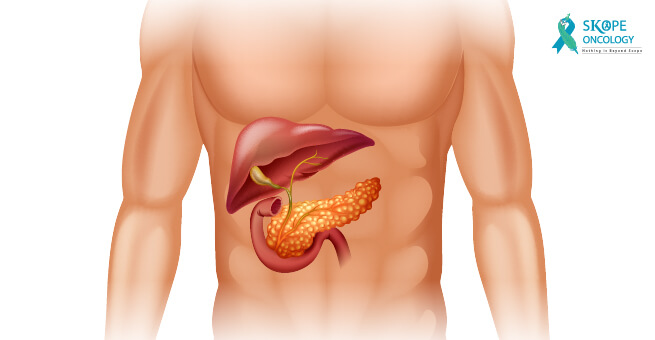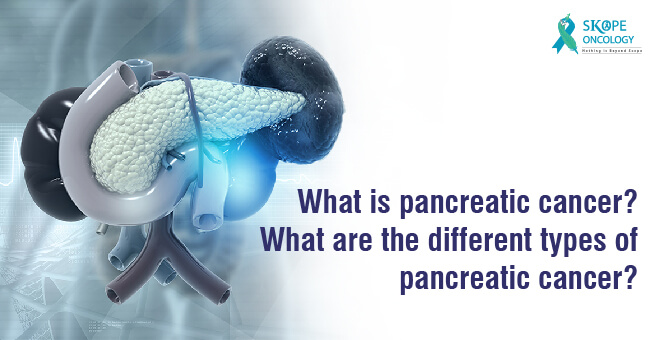What is the pancreas?
The pancreas is an elongated, tapered organ located behind the stomach in the upper left abdomen. It is part of the digestive system and functions as an organ and a gland.
It is made up of two major components-the exocrine and endocrine components. The exocrine component makes specialised proteins called enzymes that are released into the small intestine to help the body digest and break down food.
The endocrine component makes specific hormones called insulin, glucagon, somatostatin, pancreatic polypeptide (PP), and vasoactive intestinal peptide. Insulin and glucagon help control the amount of sugar in the blood, while the other hormones play an important role in regulating the body’s metabolism.
What is pancreatic cancer?
Pancreatic cancer develops when mutations in pancreatic cells cause them to multiply uncontrollably, resulting in a mass of tissue known as a tumour.
What are the types of pancreatic cancer?
Pancreatic cancer can be divided into two categories based on where the tumour originates from, namely, exocrine pancreatic cancer and neuroendocrine pancreatic cancer. Each category has several types of cancer that may differ in their symptoms and prognosis.
Exocrine Pancreatic Cancer
Exocrine pancreatic cancers account for more than 95 percent of all pancreatic cancers. They develop from the exocrine cells that are composed of the exocrine gland and pancreatic ducts.

The following are the different types of exocrine pancreatic cancer:
- Adenocarcinoma
Adenocarcinoma, also known as ductal carcinoma, develops in the lining of the pancreatic ducts and is the most common type of pancreatic cancer that accounts for more than 90 percent of pancreatic cancers.
However, the cancerous growth may also develop from the cells that create pancreatic enzymes, called acinar cell carcinoma, which accounts for 1 to 2 percent of exocrine cancers.
Symptoms may include abdominal pain, nausea, weight loss, skin rash, and joint pain.
- Squamous Cell Carcinoma
Squamous cell carcinoma is an extremely rare type of exocrine cancer that forms in the pancreatic ducts. It is entirely made up of squamous cells, which are not typically seen in the pancreas, indicating the metastatic stage of the disease with a poor prognosis.
- Adenosquamous Carcinoma
Adenosquamous carcinoma is a rare type of pancreatic cancer that has the characteristics of both ductal adenocarcinoma and squamous cell carcinoma, accounting for about 1 to 4 percent of exocrine pancreatic cancers. Compared to adenocarcinoma, adenosquamous carcinoma is a more aggressive tumour with a poorer prognosis.
- Colloid Carcinoma
Colloid carcinoma is another rare type that accounts for about 1 to 3 per cent of exocrine pancreatic cancers. This type of cancer is less likely to spread to other organs, is easier to treat, and thus has a better prognosis.
Endocrine Pancreatic Cancer
Endocrine tumours are also known as pancreatic neuroendocrine tumours (PNETs) or islet cell tumours. They are much less common than exocrine tumours, accounting for about 7 percent of all pancreatic cancers.
A pancreatic neuroendocrine tumour can be functioning (produces hormones) or nonfunctioning (does not produce hormones). Functioning neuroendocrine tumours are named based on the type of hormone produced.
The following are the different types of functional endocrine tumours and the respective hormones produced by them:
- Insulinoma (Insulin)
- Glucagonoma (Glucagon)
- Gastrinoma (Gastrin)
- Somatostatinoma (Somatostatin)
- VIPomas (Vasoactive Intestinal Peptide)
- PPomas (Pancreatic Polypeptide)
Pancreatic cancer is very difficult to detect as the pancreas is located deep within your abdomen and is surrounded by many other organs, and detecting a tumour through a routine physical exam is highly unlikely. As a result, most pancreatic cancers are detected in their advanced stages after the cancer has spread to other organs.
After determining the type and stage of the cancer, treatment options are considered in accordance with the treatment protocols. While less advanced cancers may only require less invasive options, pancreatic cancer in its advanced stages frequently requires palliative treatment options.
References:
- https://my.clevelandclinic.org/health/body/21743-pancreas#:~:text=The%20pancreas%20is%20an%20organ%20and%20a%20gland.,of%20sugar%20in%20your%20bloodstream.
- https://columbiasurgery.org/pancreas/pancreas-and-its-functions
- https://www.healthline.com/health/pancreatic-cancer/staging#stages
- https://www.cancer.net/cancer-types/pancreatic-cancer/introduction
- https://www.cancercenter.com/cancer-types/pancreatic-cancer/types
- https://www.hopkinsmedicine.org/health/conditions-and-diseases/pancreatic-cancer/pancreatic-cancer-types#:~:text=Pancreatic%20cancer%20types%20can%20be,in%20their%20symptoms%20and%20prognosis.





